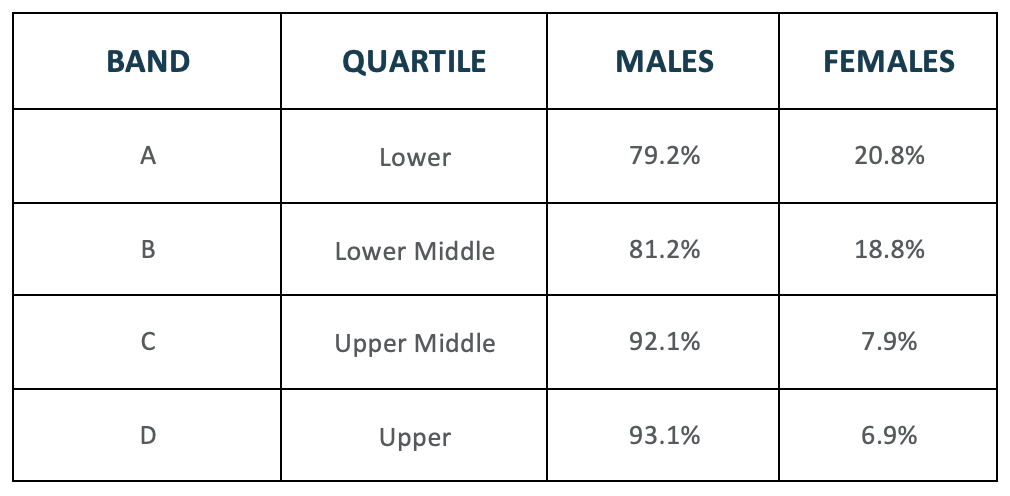Gender Pay Gap Report 2023
FOREWORD
At Vergo Pest Management Ltd, we know that diversity in gender and all other forms amongst our workforce is critical for building a successful, robust, and sustainable business. We strive to be an employer of choice that recognises and rewards all talent equally, and we understand the importance of gender equality and are committed to closing the gender pay gap.
This report provides an analysis of the gender pay gap within Vergo Pest Management Ltd as of 5th April 2023, it highlights the findings of our assessment, the measures we have put in place to address the pay gap, and our plans towards achieving gender pay parity. The gender pay gap measures the difference between the average earnings of men and women, expressed relative to men’s earnings. It is important to distinguish this from equal pay, which requires employers to give men and women equal pay who carry out the same jobs or similar jobs.
METHODOLOGY
The data used in this report has been collected and analysed according to the statutory guidance for Gender Pay Gap reporting. The figures have been calculated based on the gross earnings of all employees – full-time and part-time – within the company and includes ordinary pay (salary, allowances, shift premiums, and commission payments) and bonus pay, and excludes other payments e.g. overtime payments.
PAY QUARTILES BY GENDER
This table shows our workforce divided into four equal-sized groups based on hourly pay rate. The Lower quartile includes the lowest-paid 25% of employees, and the Upper quartile covers the highest-paid 25%.

The percentage of male to female employees in each quartile is 79.20% or more meaning that for every 3.81 male employees, there is 1 female employee.
OUR GENDER PAY GAP
This is our annual gender pay gap report for the snapshot date of 5 April 2023.
- Our mean gender pay gap is 10.38%.
This means that for every £1 a man earns at Vergo, a woman earns approximately 89.6 pence. - Our median gender pay gap is 7.63%.
The median gender pay gap is the difference between the median (middle) male salary and the median (middle) female salary, expressed as a percentage of the median male salary. The median is not affected by the very high or very low salaries in the way the mean is, so it can provide a more accurate representation of the pay gap experienced by the typical employee. This means that for every £1 a typical male employee earns at Vergo, a typical female employee earns approximately 92.37 pence. - Our mean gender pay gap in bonus pay is 53.01% as a percentage of men’s pay.
On average, women’s bonuses are 53.01% less than those awarded to men, which translates to women receiving approximately 46.99 pence for every £1 of bonus pay given to a male employee at Vergo. This notable difference underscores a significant variance in bonus allocation between men and women, pointing to a pronounced gender bias towards men in senior roles, with higher salaries that attract bonuses within our organisation. - Our median gender pay gap in bonus is 20% as a percentage of men’s bonus pay.
This means that the median (or middle) bonus amount that women receive is 20% lower than the median bonus amount that men receive. Essentially, if you line up all the bonus payments to male employees from the lowest to the highest and do the same for female employees, the bonus at the middle of the female list would be 20% less than the bonus at the middle of the male list. This measure gives a sense of the typical bonus pay gap between male and female employees, showing that, on average, for every £1 of bonus pay received by a man, a woman receives 80 pence. This calculation is based on the middle figures of the distribution and is not as influenced by extreme values as the mean is, providing a different perspective on the pay disparity in bonuses. - The results show the proportion of male employees receiving a bonus was 71.35%, whereas the proportion of female employees receiving a bonus was 70.9%.
WHY DO WE HAVE A GENDER PAY GAP?
We are committed to equal opportunities and treatment for all employees, regardless of gender or any other characteristic. We have a clear policy of paying employees equally for the same or equivalent work, regardless of their gender (or anything else). We conduct regular pay and benefits audits, provide equal pay training for all employees involved in pay reviews, and evaluate job roles and pay grades to ensure fairness.
The gender pay gap, including both regular pay and bonus disparities as outlined in this report, stems from a complex interplay of factors. These factors range from societal norms and occupational segregation to individual choices. Below are key reasons contributing to the existence of our gender pay gap:
- Occupational Segregation: This is one of the most significant factors contributing to the gender pay gap. It refers to the concentration of men and women in different professions, industries, or roles that traditionally are considered “male-dominated” or “female-dominated.” If higher-paying positions (for example senior IT roles) and sectors are predominantly occupied by men, this will naturally lead to a pay gap. The pest control industry has traditionally been dominated by men, and Vergo adheres to this industry norm with significantly more men than women in our company (349 men to 55 women). Consequently, our report mirrors this gender imbalance.
- Vertical Segregation: Also known as the “glass ceiling,” this refers to the disparity in the levels of hierarchy within organisations. In the UK, Men are often overrepresented in senior, executive positions, which typically offer higher salaries and bonuses, contributing to the overall pay gap. Our executive leadership team is made up of twelve individuals, 10 of whom are male.
- Part-Time Work and Flexible Hours: Women are more likely to work part-time or in roles with more flexible hours, often due to caregiving responsibilities. Part-time roles on occasion pay less not just per hour but also in terms of career progression opportunities, this affects the average earnings of women. The majority of our part-time employees are female.
- Career Interruptions: Women are more likely to take breaks from their careers for childcare and other family-related responsibilities. These interruptions can have a lasting impact on career progression and earning potential.
- Bonus Pay Gap: The disparity in bonus pay reflects differences in the roles men and women occupy at Vergo.
We are confident that our gender pay gap is not because we pay men and women differently for the same or equivalent work. Instead, our gender pay gap is because men and women work in different roles, and those roles have different salaries. As the majority of our workforce is male, and we have a high proportion of males in higher-paid roles, this skews the overall pay and bonus figures.
HOW DOES OUR GENDER PAY GAP COMPARE WITH OTHERS?
At the time of reporting, most of our workforce is operational and male in gender. However, our median gender pay gap is lower than the national average median gender pay gap, which is 14.3% (according to the October 2023 ONS ASHE figures) by 6.67%. The median gender pay gap has also decreased by approximately 42.63% year on year from 27% in 2021 and 13.3% in 2022 to 7.63% in 2023.
WHAT ARE WE DOING TO CLOSE OUR GENDER PAY GAP?
Our 2023 Gender Pay Gap report reveals a positive trend towards reducing the gender pay disparity within the company. We’re pleased that our efforts are evident in the improvements seen in the median gender pay gap and median bonus gap from 2022 to 2023. Although the mean gender pay gap has slightly increased, the significant progress in the median measures and the efforts to ensure equitable bonus distribution demonstrates the company’s ongoing commitment to gender equality and reducing the gender pay gap.
We are committed to doing everything we can to continue to reduce the gap. We know this will be challenging in a male-dominated industry where attracting more women into the sector is difficult, particularly in operational roles, which primarily fall in the lower and lower middle quartiles.
We believe that addressing the gender pay gap requires a multifaceted approach. We continue to conduct regular pay audits and address any pay disparities that are identified, as well as areas that need improvement to eliminate any gender bias. We are in the process of implementing transparent pay scales, offering support for career progression regardless of gender, and are on a journey to build equitable representation in all roles and levels within the organisation. We are also actively working to counteract bias and discrimination in our candidate attraction and recruitment practices and the workplace.
We know achieving a representational balance between male and female colleagues is critical to closing the gender pay gap, and we will continue recruiting women to undertake operational front-line pest control roles. Building our female representation in these roles will also create a pipeline of women for future middle and senior manager roles.
In isolation, none of these initiatives will remove the gender pay gap, and it will take some time for a real impact to be seen. However, we will continue to monitor and report on what we are doing to reduce the gender pay gap.

James Gilding, CEO
Vergo Pest Management Ltd
View our previous Gender Pay Gap Reports:
